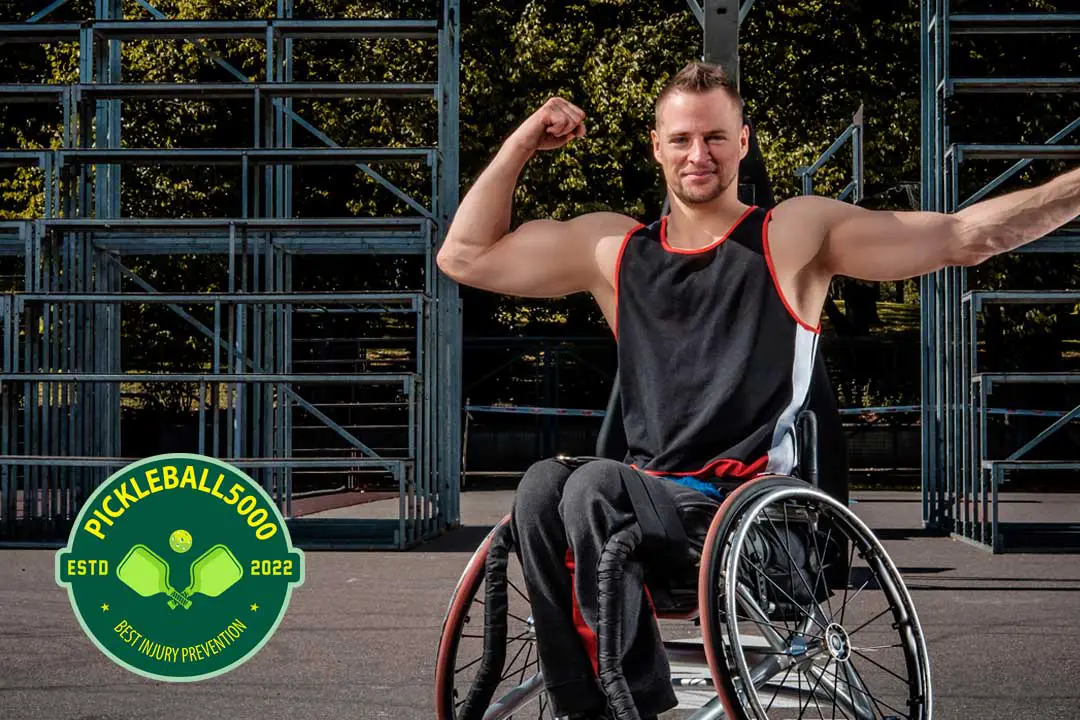What is wheelchair pickleball?
Wheelchair pickleball is a fun and fast paced, adaptive version of the traditional pickleball sport in which one or more players on the court is in a wheelchair. Wheelchair pickleball may be played as singles of doubles. The first US pickleball tournament with a wheelchair division was conducted in 2019 according to PickleballUniversity.com.
The following video is a great explanation of wheelchair pickleball also called para pickleball.
Rules for Wheelchair Pickleball
The rules for wheelchair pickleball are overall very similar to conventional pickleball. Players must obay the same no volley zone, line calls, and rules for serving and faults.
Below are the official rules from USA Pickleball.
* Resources:
SECTION 14 – WHEELCHAIR RULES
14. A. Basic Play.
The wheelchair is considered to be part of the
player’s body, and all applicable rules that apply to a player’s
body will apply to the wheelchair except in the non-volley
zone as listed below. All applicable rules that apply to
standing players apply to players in a wheelchair except as
listed below.
14. B. Double-Bounce Rule.
The wheelchair pickleball player is
allowed to double bounce the ball on their side of the net.
The second bounce can be anywhere inside or outside of the
court boundaries.
14. C. Service.
14.C.1. Server shall be in a stationary position and is then
allowed one push before striking the ball.
14.C.2. At the time the server strikes the ball, the server
shall not touch the playing surface in an area
outside the confines of the serving area with any
wheel.
14. D. Non-Volley Zone (NVZ).
The double-bounce rule applies to
the NVZ.
14.D.1. A wheelchair player may strike a ball in the NVZ on
a volley. It is a fault only if the larger rear wheels
contact the NVZ.
14.D.2. After entering the NVZ, the player’s larger rear
wheels must return to outside the NVZ boundaries
before hitting a volley or it is a fault.
14. E. Wheelchair/Standing Pickleball.
14.E.1. When a wheelchair pickleball player is playing with
or against a standing person in singles or doubles,
the rules of pickleball for standing players shall

16.A. Basic Play
“The wheelchair is considered part of the player’s body and all applicable rules that apply to a player’s body will apply to the wheelchair except in non-volley zone as listed below.
All applicable rules which apply to standing players apply to those in a wheelchair except as listed below.”
16.B. Two Bounce Rule
“The wheelchair pickleball player is allowed two bounces of the ball on his or her side of the net. The second bounce can be anywhere inside or outside of the court boundaries.”
16.C. Service
- “C.1. Server shall be in stationary position, and then allowed one push before striking ball.
- C.2. At the time the server strikes the ball, the server shall not touch with any wheel: any baselines, sidelines, center lines or the extended center or sidelines.”
16.D. Non-Volley Zone (NVZ) (two bounce rule applies)
- “D.1. When a wheelchair player strikes a ball in the NVZ, on a volley, it is a fault only if the larger-rear wheels contact NVZ.
- D.2. Upon exiting the NVZ, after striking a bounced ball, the player’s larger-rear wheels must return to outside the NVZ boundaries (so no rear wheel contact is made in the NVZ) before hitting a volley, or it is a fault.”
16.E. Wheelchair/Standing Pickleball
- “E.1. When a wheelchair pickleball player is playing with or against a standing person in singles or doubles, the rules of pickleball for standing players shall apply to all standing players while the wheelchair pickleball rules shall apply to all wheelchair players.”
16.F. Singles Wheelchair Pickleball
- “F.1. Singles play with one or both players in a wheelchair shall be played on half court. The server and the receiver shall serve, receive and play the entire point from their respective service and receiving court.”
As a physical therapist and strength coach myself, I love seeing people with a wide variety of capabilities enjoy the sport of pickleball.

